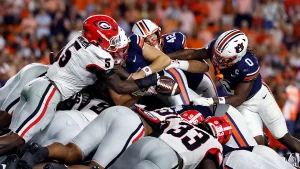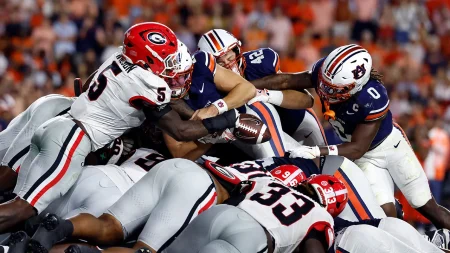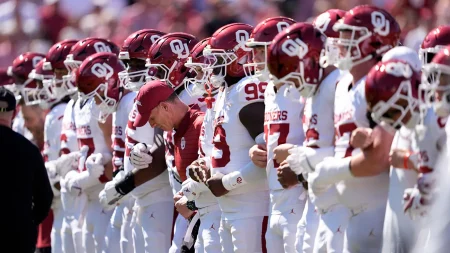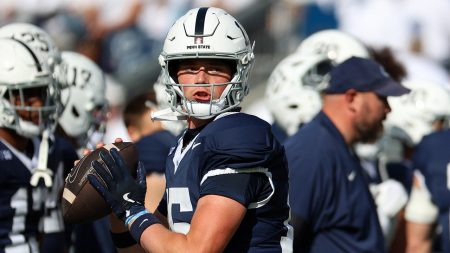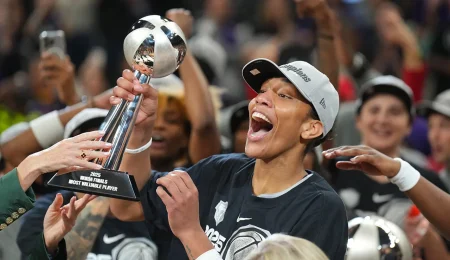High School Football Makes Way for Unexpected Feathered Tenants
In a twist of irony that highlights the intersection of human activities and wildlife conservation, the Apple Valley High School Eagles football team in Minnesota has found itself displaced by another raptor species. Ospreys, large birds of prey with impressive six-foot wingspans, have established a nest atop one of the stadium’s floodlight poles, forcing significant schedule adjustments for the school’s athletic program. As Cory Hanson, the school’s athletic director, put it with a mixture of bewilderment and amusement: “When you tell someone this story of ‘Wow, we have to reschedule because there’s an osprey nest in our stadium,’ they’re like, ‘You can’t make this type of stuff up, right?'” The situation perfectly captures the unexpected challenges that arise when human structures become attractive nesting sites for protected wildlife species.
The presence of the osprey nest has created a unique logistical challenge for the high school. Since ospreys are protected under both federal and state law, the football team cannot use the stadium lights during evening games, as the illumination could disturb the birds and their young. This protection status means the school has no choice but to reschedule all home games to daytime hours. School officials first noticed the nest in June and have been monitoring the situation closely ever since, even using drones to check on the progress of the chicks without causing disturbance. The school community has shown remarkable adaptability, with Hanson noting that other schools have been accommodating in finding alternative game locations and times—demonstrating how wildlife conservation can bring communities together in problem-solving.
According to Heidi Cyr from the Minnesota Department of Natural Resources, there is a silver lining to this situation: the timing. The osprey chicks are nearly ready to take their first flights, which means the school should be able to remove the nest within about a week after the young birds have successfully fledged. “Luckily for Apple Valley, they should be able to remove the nest within probably a week because the birds have already taken some of their first flights,” Cyr explained. This timeline provides some relief for the school, as they won’t have to modify their entire football season around their feathered residents. The situation highlights the often temporary nature of wildlife conflicts and the importance of patience in allowing natural cycles to complete before intervening.
The school is taking a proactive approach to prevent similar situations in the future while still supporting local wildlife. Officials plan to relocate the nest to another platform on school grounds, away from the stadium lights, and will install deterrents on the current nest location. The hope is that the ospreys will return next year but choose the new, more appropriate nesting platform instead of the stadium lights. “So if anyone sees that happening, don’t worry,” Cyr reassured the public, “The birds are safe. They’ve successfully left the nest, and they’re on their way to becoming adults themselves.” This balanced approach demonstrates how human needs and wildlife conservation can coexist with thoughtful planning and a willingness to accommodate natural behaviors.
The osprey’s choice of nesting location speaks to the bird’s natural preferences and adaptability to human-altered landscapes. Ospreys typically seek high places with clear views for their nests, making stadium lights an attractive option from their perspective. The impressive scale of their nest-building activities caught the attention of school staff early on. As Hanson recounted, “When you see these large birds flying across your field with these humongous sticks, you start to ask questions like, ‘What is going on here?’ And you take one look at that nest, right? And you’re like, ‘OK, this is not your average bird.'” This firsthand observation highlights the awe-inspiring nature of these birds and their architectural abilities, turning what could be seen as an inconvenience into an educational opportunity for the school community.
The situation at Apple Valley High School reflects a broader conservation success story. The Minnesota Department of Natural Resources sometimes issues permits for nest removal when ospreys build on critical infrastructure like utility poles or cell towers, but typically denies these requests if chicks are present—prioritizing the birds’ welfare. Importantly, ospreys were removed from Minnesota’s species of special concern list in 2015, following successful population rebuilding efforts. The presence of these birds at the high school stadium, though temporarily disruptive to human activities, is a testament to these conservation achievements. The accommodation made by the Apple Valley Eagles for their feathered namesakes represents a small but meaningful contribution to continued wildlife recovery, demonstrating how everyday decisions in our communities can support broader environmental goals.


